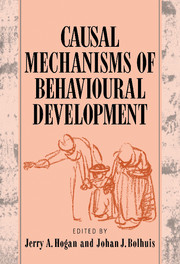Book contents
- Frontmatter
- Contents
- List of contributors
- Foreword: Introducing Jaap Kruijt
- Preface
- Part one Introduction
- Part two Development of perceptual and motor mechanisms
- 3 The neural basis for the acquisition and production of bird song
- 4 Sexual imprinting as a two-stage process
- 5 The influence of social interactions on the development of song and sexual preferences in birds
- 6 Perceptual mechanisms in imprinting and song learning
- 7 The development of action patterns
- Part three Development of behaviour systems
- Part four Development of cognition
- Part five Learning and development
- Author index
- Subject index
5 - The influence of social interactions on the development of song and sexual preferences in birds
Published online by Cambridge University Press: 19 January 2010
- Frontmatter
- Contents
- List of contributors
- Foreword: Introducing Jaap Kruijt
- Preface
- Part one Introduction
- Part two Development of perceptual and motor mechanisms
- 3 The neural basis for the acquisition and production of bird song
- 4 Sexual imprinting as a two-stage process
- 5 The influence of social interactions on the development of song and sexual preferences in birds
- 6 Perceptual mechanisms in imprinting and song learning
- 7 The development of action patterns
- Part three Development of behaviour systems
- Part four Development of cognition
- Part five Learning and development
- Author index
- Subject index
Summary
Bird song and sexual imprinting in birds are ideal systems for studying behavioural development, as we have seen already (DeVoogd, Bischof, this volume). They are also ideal systems to compare because of the many parallels between them (see also ten Cate, this volume). In this chapter I compare aspects of song learning and sexual imprinting in birds to show how the relationship between them contributes to our general understanding of how behavioural processes interact during development. I shall focus on the importance of social interactions for both song learning and sexual imprinting, discussing the circumstances under which social interactions can override two key features of imprinting-like processes, namely sensitive phases and stability, and describing some experiments that demonstrate which features of social interaction seem to be important (see ten Cate, this volume; Bolhuis, 1991, for the role of social interaction in filial imprinting). Finally, I shall adopt an interdisciplinary approach by linking the behaviour with its underlying neural substrate. An understanding of the role social interaction plays in learning and memory is important for two reasons: it contributes towards our general understanding of the complex process of behavioural development, and may help to elucidate the fascinating problem of how memory is stored and processed in the brain.
Sexual imprinting
Although the extraordinary phenomenon of newly hatched precocial birds following humans and subsequently developing sexual preferences for them had been described long before, the term imprinting, or ‘Prägung’, was popularised by Konrad Lorenz (1935), who drew attention to its biological significance.
- Type
- Chapter
- Information
- Causal Mechanisms of Behavioural Development , pp. 98 - 115Publisher: Cambridge University PressPrint publication year: 1994
- 3
- Cited by



